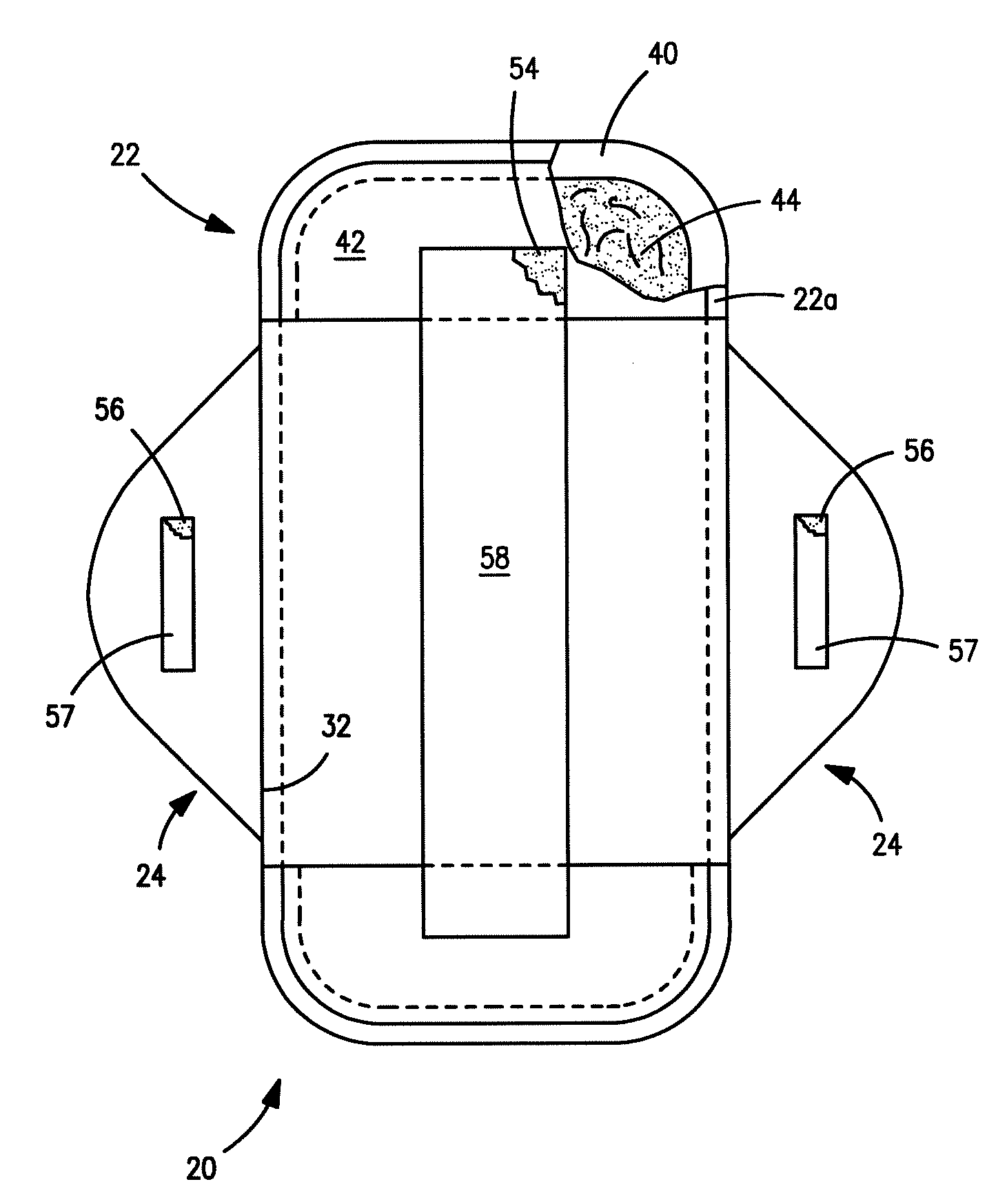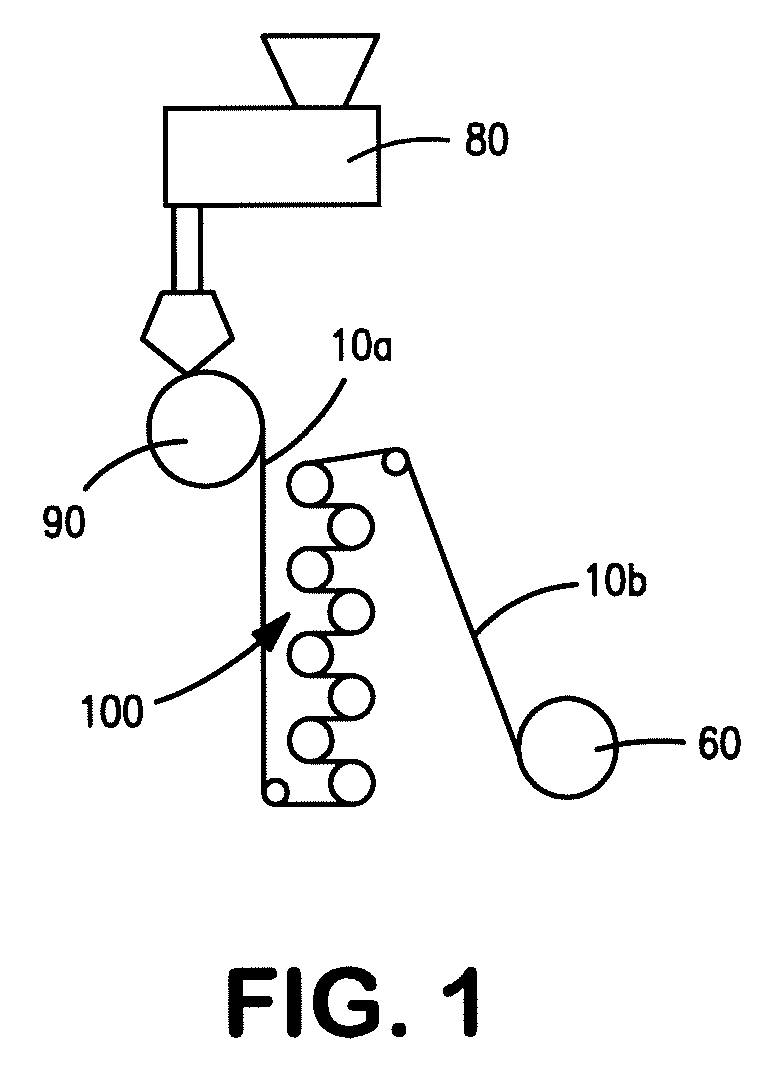Biodegradable water-sensitive films
a technology of biodegradable and water-sensitive films, applied in the direction of layered products, bandages, transportation and packaging, etc., can solve the problems of release-coated films or papers, not readily dispersed in water, blockages in the toilet,
- Summary
- Abstract
- Description
- Claims
- Application Information
AI Technical Summary
Benefits of technology
Problems solved by technology
Method used
Image
Examples
example 1
[0073]A thermoplastic hydroxypropylated starch was formed as follows. Initially, a mixture of a hydroxypropylated starch (Glucosol 800, manufactured by Chemstar Products Company, Minneapolis, Minn.), surfactant (Excel P-40S, Kao Corporation, Tokyo, Japan), and plasticizer (sorbitol) was made at a ratio of the 66 parts of starch, 4 parts of surfactant, and 30 parts of plasticizer. A Hobart mixer was used for mixing. The mixture was then added to a K-Tron feeder (K-Tron America, Pitman, N.J.) that fed the material into a co-rotating, twin-screw extruder (ZSK-30, diameter of 30 mm) that was manufactured by Werner and Pfleiderer Corporation of Ramsey, N.J. The screw length was 1328 millimeters. The extruder had 14 barrels, numbered consecutively 1-14 from the feed hopper to the die. The first barrel #1 received the mixture at 19 lbs / hr when the extruder was heated to a temperature for zones 1 to 7 of 100° C., 110° C., 124° C., 124° C., 124° C., 110° C., and 105° C., respectively. The sc...
example 2
[0074]A plasticized polyvinyl alcohol was formed as follows. Initially, a mixture of a polyvinyl alcohol (Elvanol 51-05, a granular polymer having a degree of hydrolysis of 87.0-89.0 mole % and manufactured by DuPont) and plasticizer (sorbitol) was made at a ratio of the 80 parts polyvinyl alcohol and 20 parts of plasticizer. A Hobart mixer was used for mixing. The mixture was then added to a K-Tron feeder (K-Tron America, Pitman, N.J.) that fed the material into a ZSK-30 co-rotating, twin-screw extruder as described above. The first barrel #1 received the mixture at 25 lbs / hr when the extruder was heated to a temperature for zones 1 to 7 of 150° C., 160° C., 185° C., 190° C., 190° C., 170° C., and 110° C., respectively. The screw speed was set at 160 rpm to achieve a melt pressure of 280-300 psi and a torque of 34-40%. In some cases, a vent was also opened release steam generated due to the presence of the added water in the plasticizer and inherent moisture in the starch. The stra...
example 3
[0075]A plasticized polyvinyl alcohol was formed as follows. Initially, a mixture of a polyvinyl alcohol (Celvol 203, a polymer having a degree of hydrolysis of 87.0-89.0 mole % and manufactured by Celanese Chemicals) and plasticizer (sorbitol) was made at a ratio of the 80 parts polyvinyl alcohol and 20 parts of plasticizer. A Hobart mixer was used for mixing. The mixture was then added to a K-Tron feeder (K-Tron America, Pitman, N.J.) that fed the material into a ZSK-30 co-rotating, twin-screw extruder as described above. The first barrel #1 received the mixture at 25 lbs / hr when the extruder was heated to a temperature for zones 1 to 7 of 150° C., 160° C., 185° C., 190° C., 190° C., 170° C., and 110° C., respectively. The screw speed was set at 160 rpm to achieve a melt pressure of 280-300 psi and a torque of 34-40%. In some cases, a vent was also opened release steam generated due to the presence of the added water in the plasticizer and inherent moisture in the starch. The stra...
PUM
| Property | Measurement | Unit |
|---|---|---|
| glass transition temperature | aaaaa | aaaaa |
| glass transition temperature | aaaaa | aaaaa |
| glass transition temperature | aaaaa | aaaaa |
Abstract
Description
Claims
Application Information
 Login to View More
Login to View More - R&D
- Intellectual Property
- Life Sciences
- Materials
- Tech Scout
- Unparalleled Data Quality
- Higher Quality Content
- 60% Fewer Hallucinations
Browse by: Latest US Patents, China's latest patents, Technical Efficacy Thesaurus, Application Domain, Technology Topic, Popular Technical Reports.
© 2025 PatSnap. All rights reserved.Legal|Privacy policy|Modern Slavery Act Transparency Statement|Sitemap|About US| Contact US: help@patsnap.com



